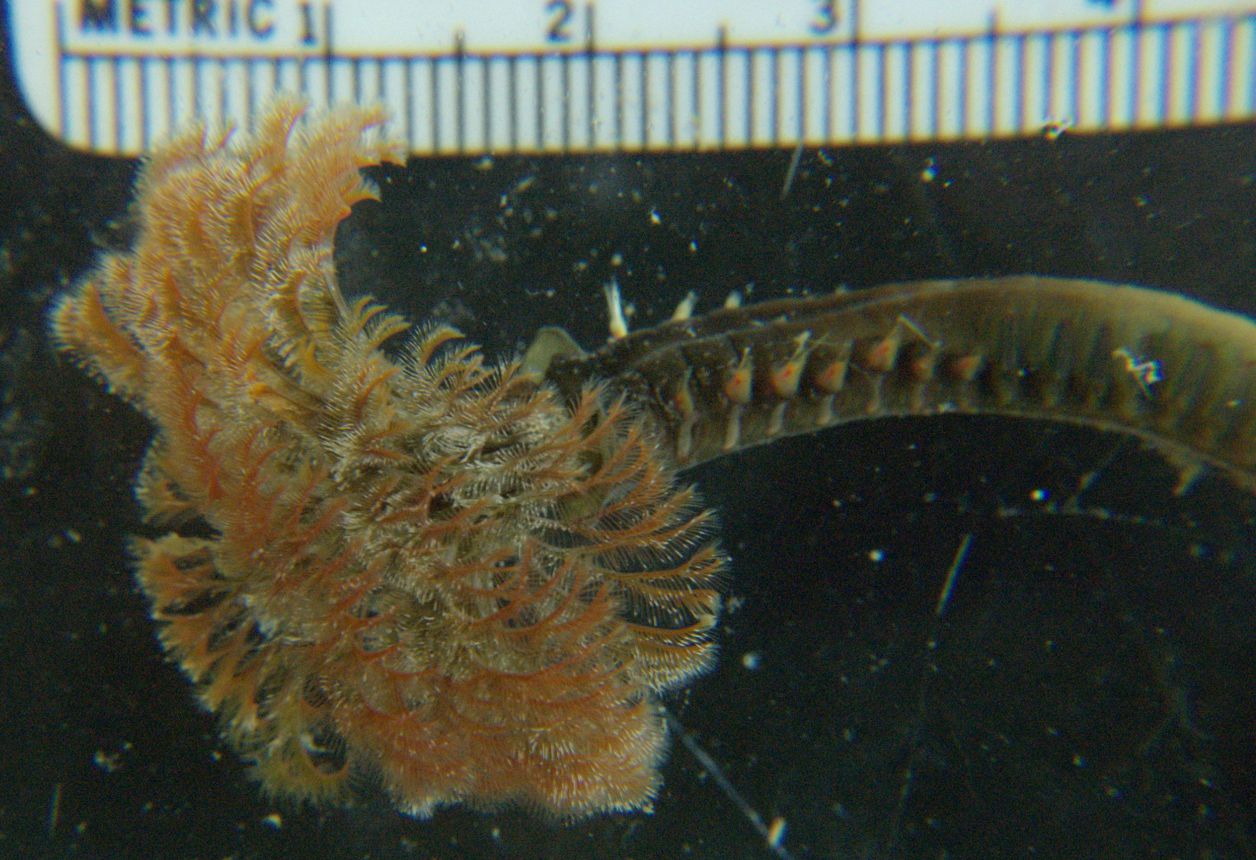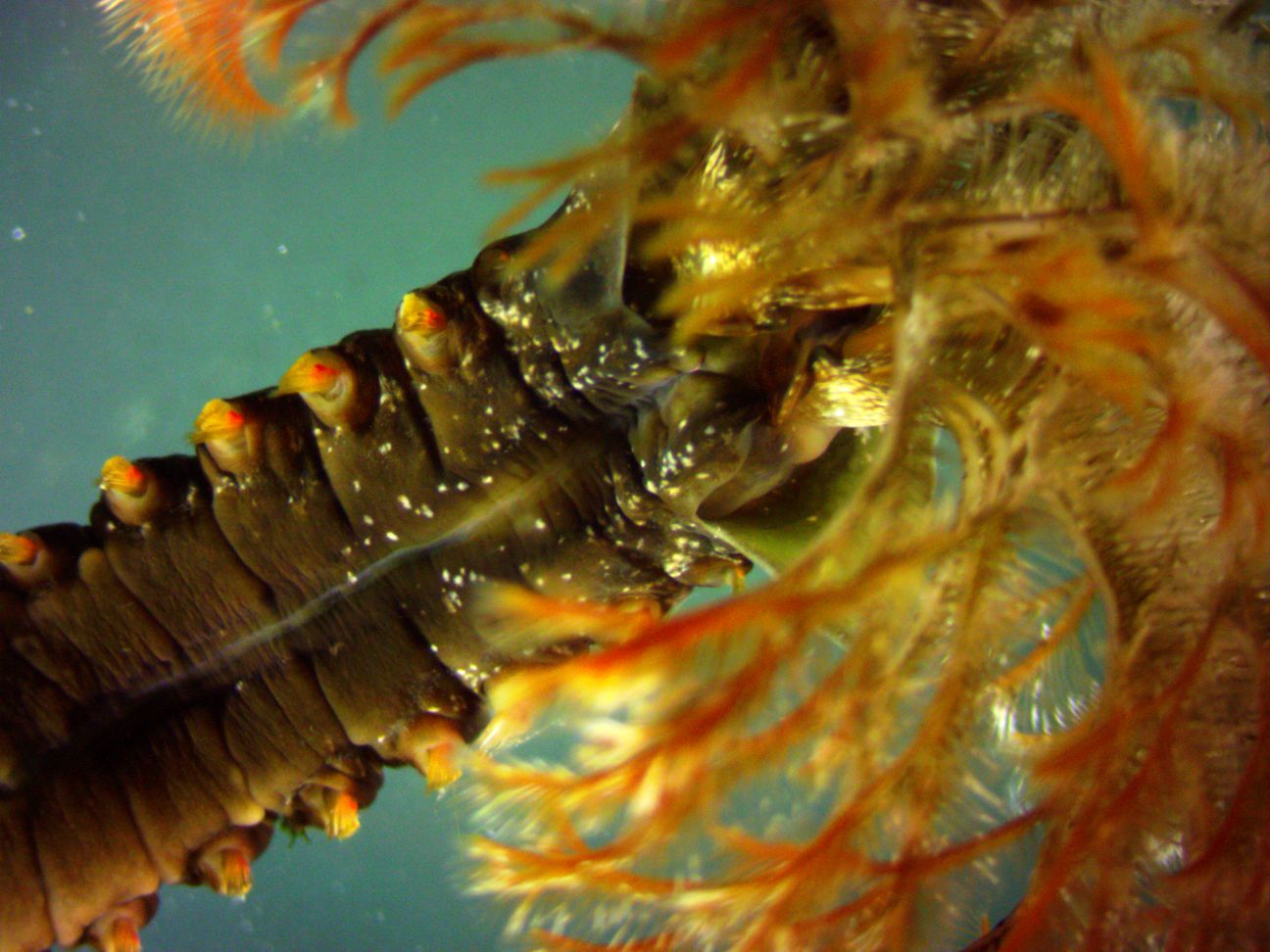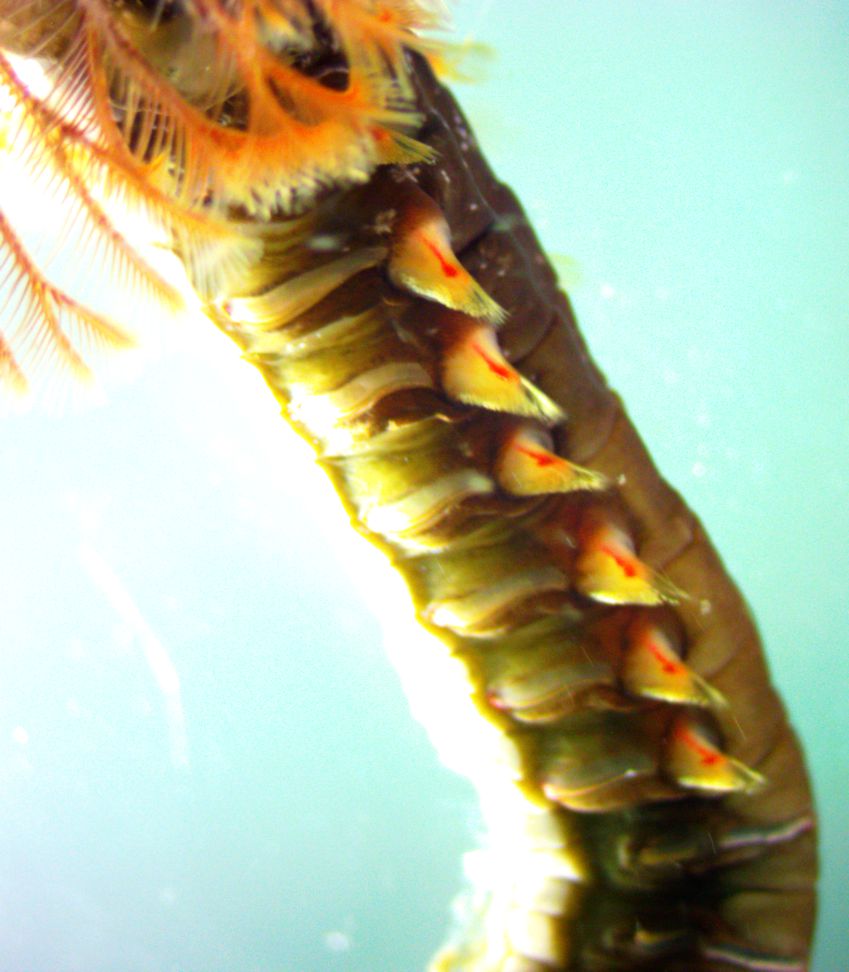Description: Like all members of Family Sabellidae (parchment tube worms), this species has a plume of pinnate, featherlike radioles on its head region and lives in a flexible, leather or parchment-like tube it has secreted. Like serpulids (calcareous tubeworms), the head has a series of pinnateradioles with which the animal suspension feeds. Unlike serpulids, the radioles are not spiraled but form a series of semicircles around the head region. In Schizobranchia insignis, the radioles are dichotomously branched (see photo above). Many radioles have a series of several black eyespots (photo). The thorax consists of just the first 6-8 body segments, and has long notosetae and a row of short neurosetae (photo). The rest of the body is the long abdomen, which has short notosetae and long neurosetae. The crown of radioles is all one color and may be tan, brown, gray, greenish, reddish, or orange (photo). The posterior end of mature males body ss pink (photo) and that of females is green. Length to 16 cm (21 cm in Alaska).
How to Distinguish from Similar Species: This is the only local sabellid tubeworm with dichotomously branching radioles, except for Eudistylia vancouveri, in which a few of the radioles branch. The sabellid with most-similar looking plume is Eudistylia polymorpha, but that in that species the radioles do not dichotomously branch, and it may have bands of color on the radioles.
Geographical Range: Alaska to central California
Depth Range: Low intertidal to 46 m
Habitat: In Alaska they often attach to boulders. In the Salish Sea area they are not often found on boulders but are common on floats and docks. This species appears to be unable to regenerate a tube if removed from it (Merz, 2015)
Biology/Natural History: This is one of the most abundant species on floats in the Salish Sea area. Like other sabellids, this species is a suspension feeder. Its radioles have ocelli (eyespots), and it quickly runs down into its smoothly lined tube (photo) when a shadow passes over it. Living in a tube makes it difficult to defecate wastes from the anus. Sabellids solve this problem by having a ventral ciliated groove which carries fecal wastes forward from the pygidium along the abdomen. This groove moves around to the dorsal side on the thorax and continues to the anterior end of the animal (photo), where the wastes can be released into the water.
This species tends to live in clusters of multiple individuals. May also be found associated with clusters of Eudistylia vancouveri.
Eggs are about 200 microns in diameter. Both eggs and sperm are released into the water where external fertilization takes place.
The thoracic notochaetae of this species are covered with
numerous tiny
micro-teeth (Merz,
2015)
| Return to: | |||
| Main Page | Alphabetic Index | Systematic Index | Glossary |
References:
Dichotomous Keys:Carlton, 2007
Kozloff, 1987, 1996
General References:
Kozloff,
1993
Lamb
and Hanby, 2005
O'Clair
and O'Clair, 1998
Scientific Articles:
Dales, R. Phillips, 1961. Observations on the respiration of
the sabellid polychaete Schizobranchia insignis.
Biological
Bulletin 121:1 pp 82-91
Lom, Jiri and Eugene N. Kozloff, 1967. The ultrastructure of Phalacrocleptes verruciformis, an unciliated ciliate parasitizing the polychaete Schizobranchia insignis. Journal of Crustacean Biology 33:2 p 355
Merz, Rachel Ann, 2015. Textures and traction: how tube-dwelling polychaetes get a leg up. Invertebrate biology 134:1 pp 61-77
Thomas, Florence I.M., 1994. Transport and mixing of gametes in three free-spawning polychaete annelids, Phragmatopoma californica (Fewkes), Sabellaria cementarium (Moore), and Schizobranchia insignis (Bush). Journal of Experimental Marine Biology and Ecology 179:1 pp 11-27
Web sites:
General Notes and Observations: Locations, abundances, unusual behaviors:
These two intertwined individuals show some of the variations
in plume
color. Their tubes are overgrown with Perophora
annectens tunicates,
and a Triopha
catalinae clown nudibranch is crawling among
them.
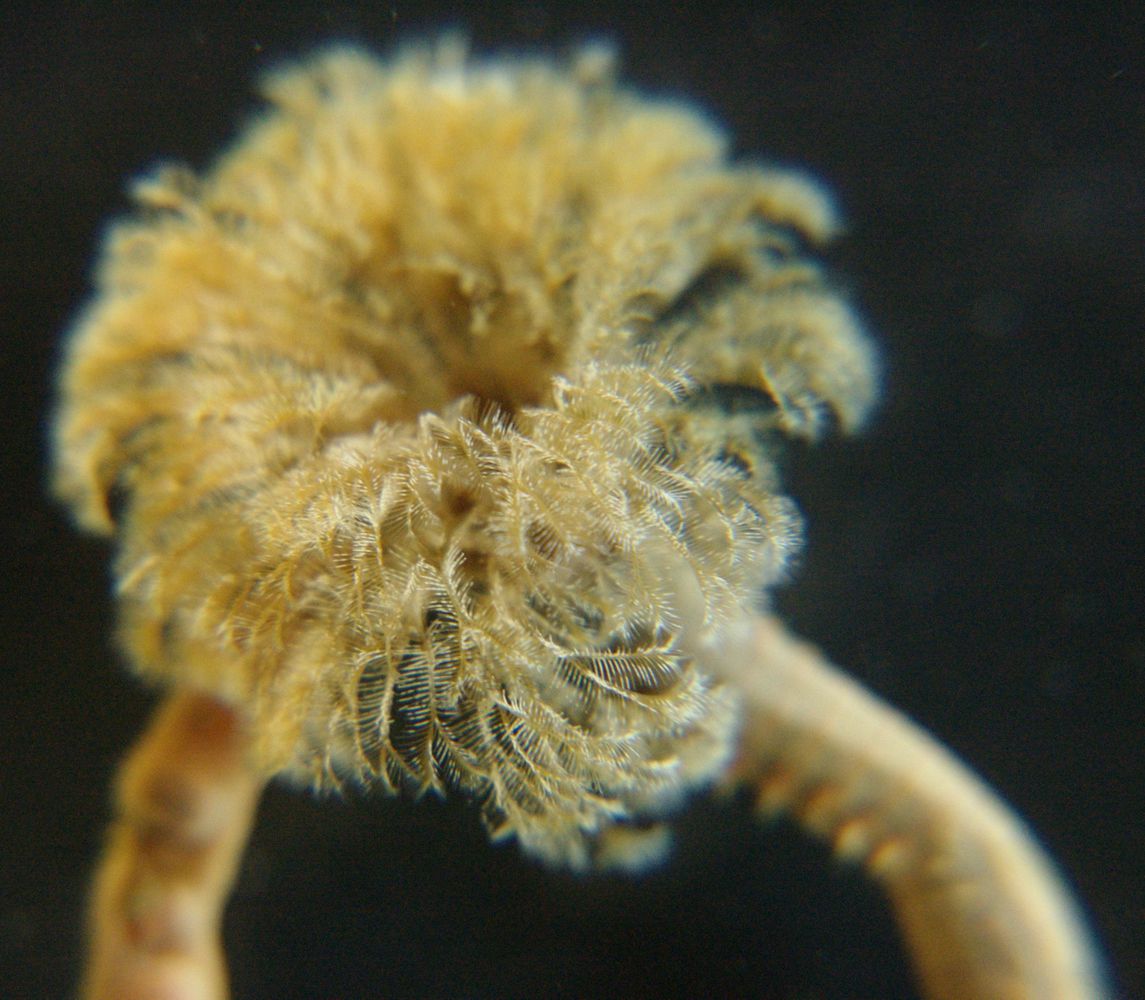
This individual, the same as in the photograph above (but removed from
its tube) shows details of the tan-colored plume.

This slit-open tube shows the smooth texture inside and the rough
texture
outside.
This dorsal view of the head shows the groove for fecal material, which runs on the dorsal side at the anterior end (thorax) of the animal. The white flecks are material which has already moved up the groove. A few white flecks can be seen in the groove, and these are moving steadily toward the head. The long notosetae are visible, the head flaps can be clearly seen at the base of the radioles, and dark eyespots can be seen on the shaft of at least one radiole.
This view of the left side of the thorax shows the long notosetae and the short neurosetae, plus the reversal of these on the abdomen at the bottom of the photo.
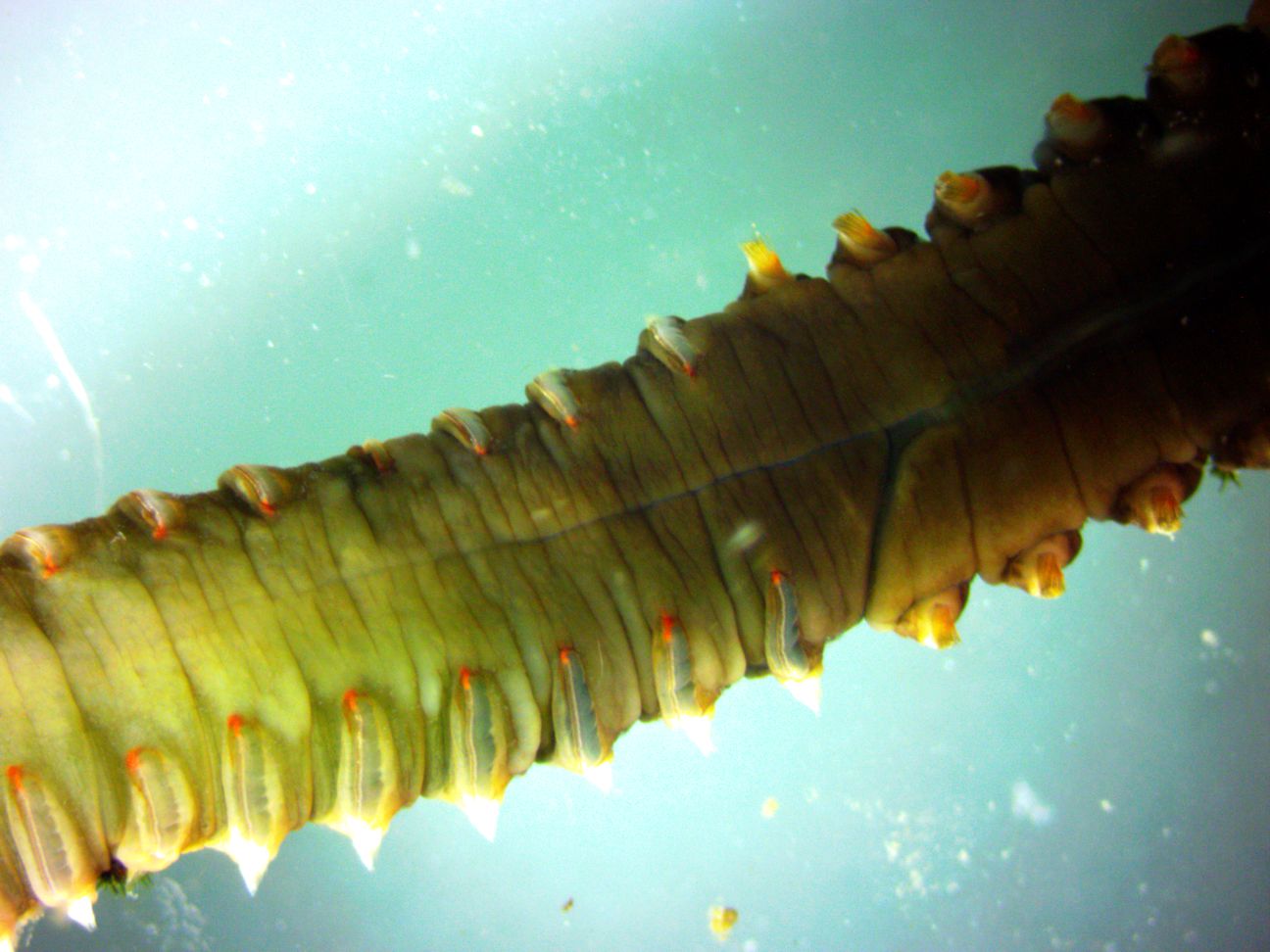
This dorsal view of the abdomen (left) and thorax (right) shows the
transition in type of setae,
and also shows the fecal groove transitioning from the ventral side on
the abdomen to the dorsal side on the thorax.
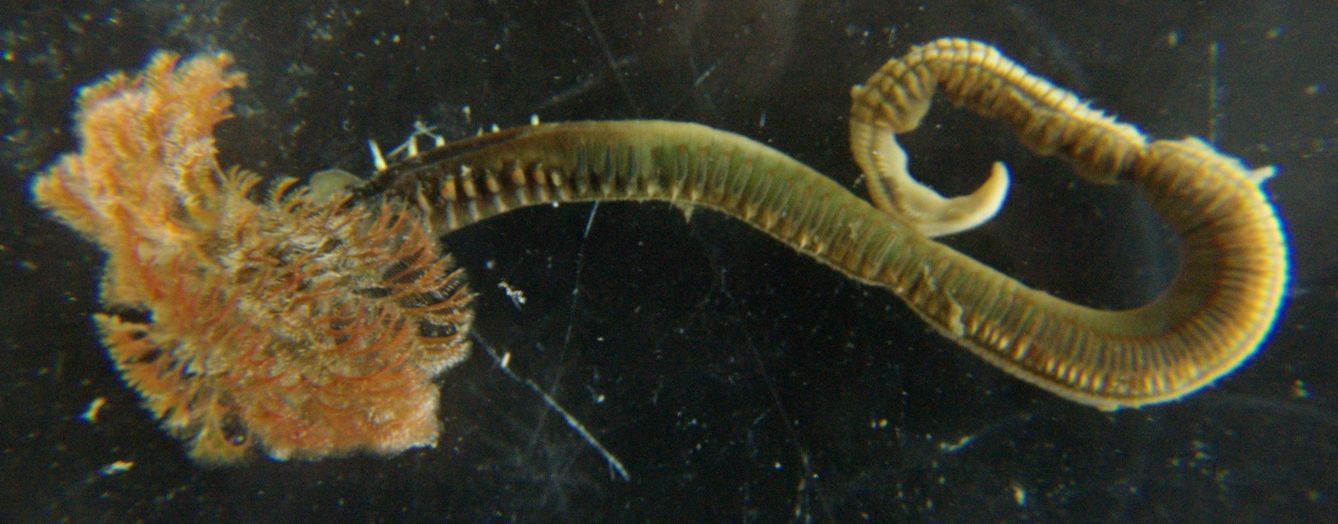
The pinkish tail end of this individual must mean that it is a male.
Authors and Editors of
Page:
Dave Cowles (2014): Created original page
CSS coding for page developed by Jonathan Cowles (2007)
Salish Sea Invertebrates web site provided courtesy of Walla
Walla University
